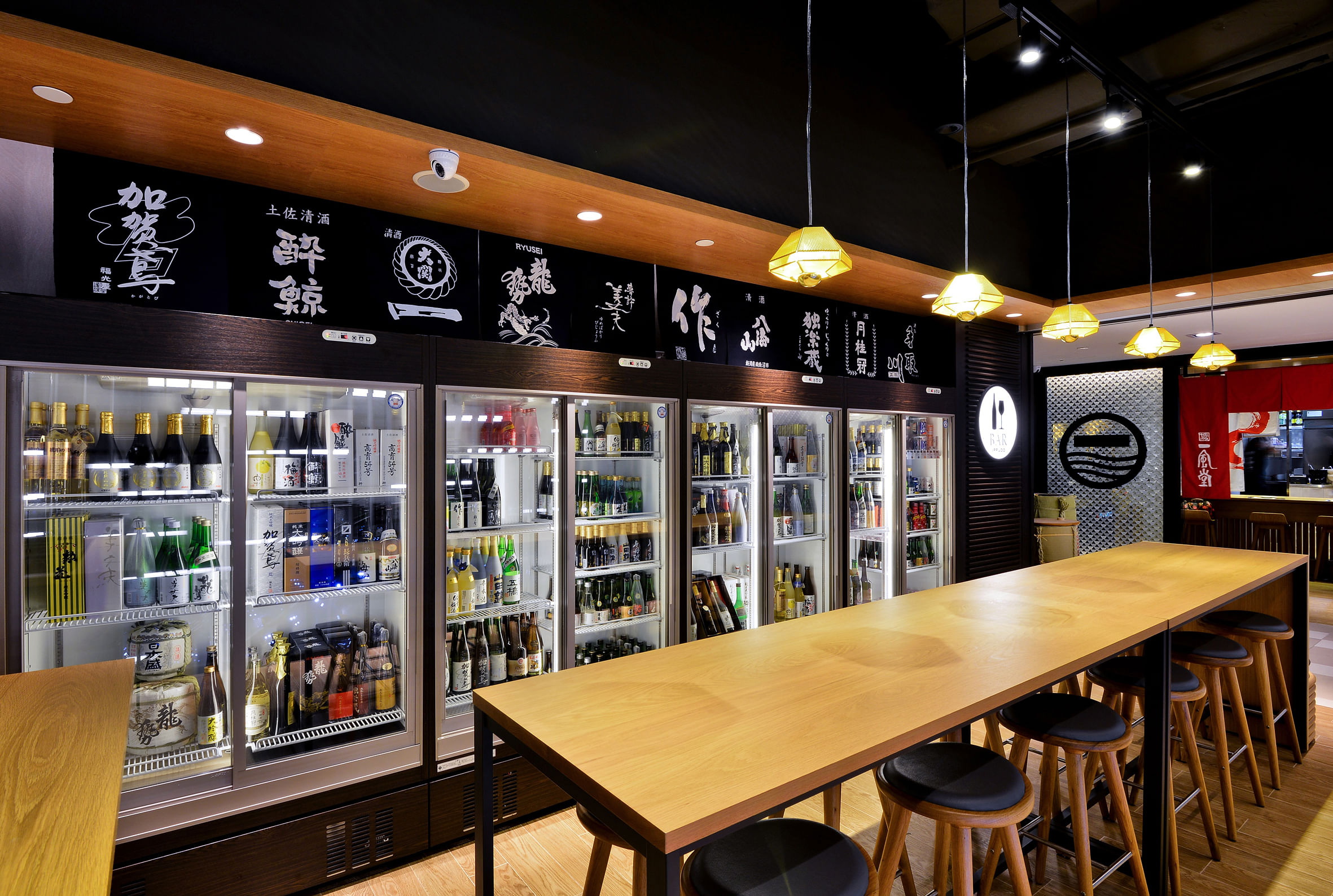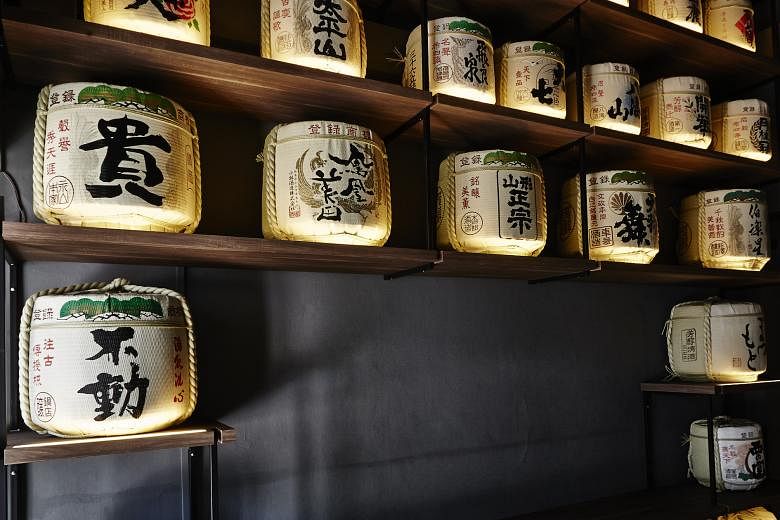Step aside Japanese whisky and beer. Sake, the fermented rice beverage, is fast becoming the hottest tipple in town.
This year, no fewer than 18 sake bars and restaurants have opened, with at least six of them opening within the last three months.
Japanese restaurants have also bumped up their sake offerings to include exclusive labels. Chef Kenjiro Hashida of Hashida Sushi and Hashida Garo, for example, now has his own Toki sake label, in collaboration with Syata Sake Brewery in Ishikawa.
Singaporeans are developing an appreciation for sake, and awareness here is gaining ground with sake booths at food-and-beverage events such as the recent Epicurean Market at Marina Bay Sands and Beerfest Asia at Marina Promenade.
More sake-related events are also in the pipeline, as there is about a month left to Oct 1 - which was designated Sake Day in 1978 by the Japan Sake Brewers Association.
Suppliers and business owners all agree that the sake scene here is still in its early stages and that more needs to be done to educate drinkers on the different grades and complexities of the drink.
-
Sake 101
-
Daiginjo
The different grades of sake refer to how much of the rice has been milled away. A daiginjo is brewed with rice, water, koji (steamed rice that has had koji mould spores cultivated in it) and distilled alcohol.
The mould breaks the rice starches down into sugars that can be fermented by the yeast cells, which then give off carbon dioxide and alcohol. At least 50 per cent of the rice is milled away.
Drink with: Sashimi, grilled white fish such as sea bream, and steamed food.
Junmai daiginjo
Like the daiginjo, at least 50 per cent of the rice is milled away. Junmai daiginjo and daiginjo fetch a high price because of the intense labour required.
Junmai refers to "pure rice", which means that no distilled alcohol is added. It is light, complex and aromatic.
Drink with: Seafood, such as prawn and salmon, and desserts.
Ginjo
At least 40 per cent of the rice is milled away. The sake has a light body with a fruity fragrance.
Drink with: Slightly oily fish that has been lightly grilled or smoked, as well as light, creamy dishes.
Junmai ginjo
Like ginjo, at least 40 per cent of the rice is milled away, but no distilled alcohol is added. The result is a medium-bodied sake.
Drink with: Fresh oysters, caviar, pizza and chicken rice.
Honjozo
Made with rice, water, koji and a small amount of pure distilled alcohol. At least 30 per cent of the rice is milled away.
Drink with: Sashimi and meat such as pork or beef.
Namazake
The term refers to unpasteurised sake and can be applied to any of the above grades. It has fresh and bright flavours with a dry finish.
Drink with: Akami (tuna), uni, anago (salt-water eel) and blue cheese.
Nigorizake
Cloudy sake. The sake is filtered through a rough cloth before fermentation is complete. Some of the rice solids are let through the cloth, which results in the cloudy appearance. Known for its rich and sweet flavours, it is best served chilled.
Drink with: Rich and spicy food, as well as desserts.
Yamahai
During the yeast starter stage, lactic acid is added and more bacteria and wild yeast cells develop. This results in a stronger flavour.
Drink with: Thai or Peranakan food as the flavours match the rich and spice-driven dishes.
• Food pairing tips from Ms Gwen Lim, chef-owner of Patisserie G; RE&S Enterprises' master chef and general manager Naoki Tsuzuki; sake sommelier Joan Lim of Japanese artisanal sake and beer company Epicurean Nomads and advanced sake professional Derrick Lim of sake importer IVGS Group.
There are still common misconceptions about sake, which advanced sake professional Derrick Lim of sake importer IVGS Group calls a "mysterious drink".
For example, some think that the drink is distilled, like vodka and whisky, while others assume that the most expensive junmai daiginjo or daiginjo are the best.
He says: "Most diners will decide based on price alone, or choose 'popular' sake labels.
"However, there is an awakening to sake flavours by a growing group of sake enthusiasts who are open to trying the many flavours of sake."
Demand for artisanal sake is also growing, says sake sommelier Joan Lim of Japanese artisanal sake and beer company Epicurean Nomads.
She says: "Consumers are starting to understand and appreciate the artisanal brewing methods adopted by the smaller brewers."
But it can be a struggle for the breweries to meet demand.
She adds: "Many breweries we work with have never exported their sake and some refuse to do so, citing supply constraints. For several breweries which we partner, our allocation is 10 cases or 120 bottles for an entire year."
Ms Maria Luisa Satoh, senior sales and marketing manager of Japanese liquor store Orihara Shoten, says: "The demand is growing surprisingly fast. We started with 35 breweries and now we carry sake from more than 70 breweries."
As a sake sommelier, she also understands the language barrier that consumers face when trying to read sake labels in Japanese.
Besides recommending that customers learn some basic kanji characters, she also suggests looking at the Sake Meter Value. It indicates the dryness or sweetness of the sake.
And as the scene continues to grow, more restaurants now have in-house sake sommeliers.
Mr Eric Li, 30, head sommelier of Japanese restaurant Waku Ghin at Marina Bay Sands, says: "A common question I get is about serving temperature. I guess many diners drink sake warm during winter in Japan.
"It is our role to advise them on sake pairing."
The scene in Singapore is not far off from that in Japan.
Mr Tadayoshi Onishi of Kiyasho Brewery in Mie says: "The younger generation in Japan do not have the habit of going out and drinking because of the economic situation. But I do think that sake has been attracting a younger generation and more women."
He sees Singapore as the biggest market in South-east Asia and his range of Jikon sake is carried by Beam Suntory. Next month, Japanese restaurant Boruto will also carry a selection of his sake.
Ms Etsuko Nakamura, who runs sake brewery tours, says Japan is going through a "sake boom" because of the increase in media coverage and publications dedicated to sake.
More sake-centric bars and izakayas are also popping up in Tokyo, she says.
"I think the next step is for sake to get out of the 'sake is for Japanese food' stereotype."
Indeed, some non-Japanese restaurants have also started to serve sake as well as offer food-pairing options.
These include Chinese restaurant Sum Yi Tai in Boon Tat Street, European restaurant Maca in Tanglin Road and Asian restaurant Coriander Leaf at Chijmes.
The market is also opening up to more modern approaches to sake. For example, Japanese restaurant Sumiya at Suntec City uses a sake dispenser to serve diners specific quantities of the drink.
Mr Naoki Tsuzuki, 48, master chef and general manager of RE&S Enterprises, which owns Sumiya, says: "The sake dispenser allows diners to try different kinds of sake."
Ms Lim of Epicurean Nomads also says that drinking from a wine glass, for instance, can release more aromas than drinking from the traditional ochoko (small sake cup).
Ms Mariko Kiyonaga, who works with Japanese-French restaurant Lewin Terrace for sake-pairing events, adds: "Drinkers in Japan enjoy drinking sake from a wine glass. It looks more elegant when you swirl the sake in the glass."
Expect more sake bars and restaurants to open as well.
Come November, Patisserie G's chef-owner Gwen Lim, 41, will open her new sake bar, called Copper on Stanley, in Stanley Street. It will offer more than 90 labels of sake from small artisan breweries.
The pastry chef says: "Lots of people haven't given sake a chance, but those who have are often surprised by how elegant and complex modern sake has become."
Her shop at Millenia Walk has held three sake workshops so far, with one more slated for Oct 1.
Marketing manager Sonia Ho, 36, who considers herself a beginner in sake drinking, is glad that the beverage has become more accessible in Singapore with the help of sake sommeliers.
She says: "I've tried sake only in Japan. It was a great experience for me because the sommelier took the time to explain the sake.
"I feel that sake in Singapore can be quite pricey, so I've been cautious about trying it here."
Financial consultant Desmond Goh, 31, says: "My friends and I find it interesting to learn about the different breweries. Now I'm curious to try it with local food."
Boruto
What: At Japanese restaurant Boruto, sister outlet to Tamashii Robataya at North Canal Road, highlights include Tatsuriki Komeno Sasayaki Kamimikusa from Honda Shoten brewery in Hyogo; Amanoto 45 Junmai Daiginjo from Asamai Brewery in Akita; and Jozan Jikagumi Muroka Nama Genshu from the Jozan Sake Brewery in Fukui. The sake is brought in by Boruto's chef-owner Patrick Tan.
The selection ranges from the pricey Juyondai Soko Junmai Daiginjo ($2,280 for a 1.8 litre bottle) from Yamagata to the unusual Amabuki Junmai Daiginjo Banana from Saga, which is fermented with banana yeast instead of the usual rice yeast. Prices range from $10 for a 100ml glass of sake to premium sake at $58.
The restaurant also serves sake cocktails as well as shochu and Japanese whisky. Next month, it will bring in a small selection of three different Jikon sake from Mie.
Where: Golden Castle Building, 80 South Bridge Road, 01-01, open: 4.30pm to midnight (sake bar), 6 to 11pm (tapas bar), Monday to Saturday, closed on Sunday
Info: Call 6532-0418 or go to boruto.com.sg

Kakure
What: Japanese restaurant Ki-sho has opened a sake bar on level 2 of its premises in Scotts Road. More than 50 labels of sake from various regions in Japan are available.
Served exclusively at Kakure is the Tatenokawa Junmai Daiginjo, Nakadori Kisho Label, from Tatenokawa brewery in Yamagata.
Other highlights on the sake list include Kinshi Masamune brewery's Matsuya Kyuubei Junmai Daiginjo from Kyoto; and Aramasa Junmai Viridian from Aramasa brewery in Akita. Pair your sake with a selection of bar bites, such as grilled black throat sea perch.
Where: Chateau TCC, 29 Scotts Road, level 2, open: 6.30pm to 1am, Monday to Saturday, closed on Sunday
Info: Call 6733-5251 or go to www.scotts29.com

Sumiya
What: You may have heard of wine dispensers; now there are sake dispensers too.
At Japanese restaurant Sumiya, a circular dispenser serves 20ml, 60ml and 120ml of sake.
It is priced at $2.20 a glass for a 20ml tasting portion.
Just buy a stored value sake card, insert it into the dispenser and pick your preferred sake and quantity.
Exclusive to Sumiya and its sister outlet Kuriya Dining are Gyokusendo Shuzou Brewery's Reisen range, and premium junmai daiginjo sake from Okinawa. From today, the restaurant is introducing a sake-pairing set ($68.80++) which comprises four dishes and soba, along with four types of sake (40ml each).
Where: Suntec Tower North Wing, Sky Garden, 3 Temasek Boulevard, 03-332/333, open: 11.30am to 3pm, 5.30 to 10pm daily
Info: Call 6235-1816 or go to www.sumiya.com.sg

Takeda Shoten
What: Mr Keisuke Takada, founder of the Ramen Keisuke chain, opened his first sake bar two months ago in Tras Link, just a few doors from his popular ramen shop, as well as gyoza and tendon outlets.
Sake options include Gasanryu Junmai Fuka from Shindo Sake Brewery in Yamagata; Dassai Junmai Daiginjyo 50 from Asahi Shuzo brewery; and Kamoshibito Kuheiji Junmai Daiginjyo from Kamoshibito Kuheiji Brewery in Nagoya.
Prices start at $12.80 for a shot of sake.
The drinks list also includes a wide range of shochu, Japanese whisky and beer.
To go with the sake, there is oden (from $3 an item), green tea chewy tofu ($6.80), steamed asari clams ($8.80) and assorted tempura ($13.80).
Where: Orchid Hotel, 1 Tras Link, 01-08, open: 1pm to midnight daily
Info: Call 6444-0880 or go to www.facebook.com/TakedaShoten

Bar Ippudo
What: Popular ramen chain Ippudo launched its 12-seat bar three months ago as a one-stop shop for sake lovers.
It carries about 80 sake labels from more than 20 sake breweries, such as Komagura - Gen Enjuku Junmai Ginjo from Mori No Kura in Fukuoka; Nishinoseki Tezukuri Junmai from Kayashima Sake Brewery in Oita; and Jozan Mizunogotoshi Junmai Ginjo from Shirataki Sake Brewery in Niigata.
Sake can be ordered by the bottle or in 180ml flasks. From Thursday to Saturday, opt for the Kagatobi sake-tasting set ($15 for a set of three types, or $12 for a set with a minimum order of two sets) from Fukumitsuya brewery in Kanazawa.
Where: Shaw Centre, 1 Scotts Road, 04-23, open: 11.30am to 10pm daily
Info: Call 6235-2547 or go to barippudo.com

Nobiro Japanese Restaurant & Sake Bar
What: The 42-seat restaurant carries more than 50 types of sake available for retail and to drink in the restaurant.
The menu includes Dassai 23 Junmai Daiginjyo from Asahi Shuzou in Yamaguchi; Kagatsuru Maeda Tosshiie Daiginjou from Yachiya brewery in Ishikawa; and Gazanryuu Daiginjou Kisaragi from Shindo Shuzuo brewery in Yamagata.
Prices start at $28 for 300ml.
Private omakase sake-pairing dinners (from $98 for three courses) are available on request.
Where: 108 Faber Drive, open: noon to 2.30pm (lunch from Wednesday to Sunday), 6 to 10.30pm (dinner from Tuesday to Sunday), 10pm to 1am (sake bar on Saturday)
Info: Call 6873-0095 or go to www.nobiro.sg
How sake is made
Kitaya Brewery (www.kitaya.co.jp) was founded in Yame, Fukuoka, 190 years ago. The brewery's seventh- generation president Kohtaroh Kinoshita, 52, took over in 1999 and has been exporting sake to countries such as France and Germany. Eunice Quek gets a first-hand look at how sake is made on a tour of the brewery.
-
To find out how to go on a sake brewery tour, read the April edition of The Life digital magazine
-
1. Download The Straits Times Star E-books app from App Store for your iPad or Google Play for your Android tablet.
2. Get The Life magazine inside the app. It is free, along with previous issues of the magazine.
* The Life is optimised for iPads and Android tablets and is best downloaded when there is Wi-Fi.
Steaming
The washed and polished rice is steamed in a vat for 50 to 60 minutes. Factors such as the weather and the percentage of rice which has been milled off can affect the time taken to steam the rice.
The rice then gets scooped out in batches from the steaming vat.
Cooling the rice
Rice used to make the koji (steamed rice that has had koji mould spores cultivated in it) is carefully spread out on cloth-covered duckboards to cool. One of the brewery's staff uses a rake to spread out the hot rice, while others use their bare hands to cool it. The rice is also fanned to speed up the cooling.
Making the mould
A special temperature-controlled room is used to make the koji. The rice is kneaded before koji mould is spread over it. The brewery staff check the koji rice constantly to ensure the mould-growing process goes smoothly.
Making a yeast starter
To make the shubo (yeast starter), rice, water, koji and yeast are added into the shubo yeasting tank. The toji (sake master) checks the temperature with a thermometer. As the temperature starts to drop, flask-cultured yeast is added and heated again. It takes from 14 to 21 days to make the shubo.
Transferring to sake tank
Rice is transferred to the sake tank in three different stages.
The first addition is in a smaller tank, while the second and third additions are in the large tanks equipped with cooling systems.
On the tour, each sake tank is marked to explain the type of sake it contains, the type of rice used and how much of the rice has been milled away.
During the tour, Mr Kinoshita scoops out some sake for sampling - which he does every day - to check the fermentation process.
After fermentation is complete, the moromi (main fermentation mash) will go through a series of processes that include pressing, pasteurising, maturing in storage tanks and bottling before getting shipped out.



